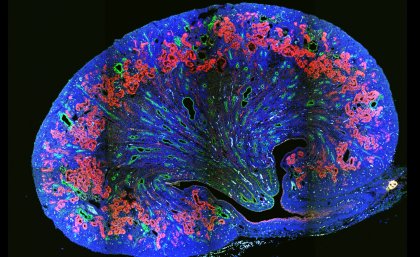
A new gene behind a rare form of inherited childhood kidney disease has been identified by a global research team.
University of Queensland researchers were part of the team that made the discovery that will improve genetic testing and could provide clues for future treatments for autosomal recessive polycystic kidney disease (ARPKD).
UQ Institute for Molecular Bioscience researcher Associate Professor Carol Wicking, a lead author of the study, said it had previously been difficult to determine the underlying cause of all cases of ARPKD.
“It was thought that errors in a gene called PKHD1 were solely to blame for this rare form of kidney disease,” Associate Professor Wicking said.
“But there was always a subset of patients who appeared to have the disease, even though they possessed a normal version of that gene.
“The aim of this study was to find other genetic culprits that could be responsible for this devastating condition.”
ARPKD causes enlarged kidneys, liver problems and high blood pressure, and often leads to renal failure in the 70 per cent of patients who survive the first weeks of life.
Using a technique called whole exome sequencing to analyse all of a patient’s genes simultaneously, researchers in Germany and the US found errors in a gene called DZIP1L in four families with ARPKD.
Associate Professor Wicking and colleagues in Australia, Singapore and Germany used laboratory-based models to confirm that errors in this gene did indeed cause kidney defects, and began to explore and understand why.
“The gene DZIP1L appears to be related to the function of cilia, which are small antenna-like extensions that project from almost all cells of the body, including those in the kidney, and play an important role in controlling vital cellular functions,” Associate Professor Wicking said.
“This gene makes a protein that acts at the base of the cilium, which, when faulty, causes a domino effect that leads to problems in cilia and, in turn, a malfunctioning kidney.
“ARPKD has a more complex cause than originally thought, and our work to understand this rare disease may eventually help us to better manage both rare and more common forms of polycystic kidney disease.”
Many patients with a rare disease wait years for a genetic diagnosis and often endure multiple misdiagnoses.
Rare Voices Australia Executive Director Nicole Millis said this exciting discovery provided much-needed answers for patients.
“These findings highlight how new genomic technologies are helping to find answers for patients with rare diseases, giving them more certainty about their condition.
“Having a genetic diagnosis also gives patients and their families a chance to connect with other people living with a similar rare disease and build vital support networks,” Ms Millis said.
The research, published in Nature Genetics (DOI: 10.1038/ng.3871), was funded by the Australian National Health and Medical Research Council, The University of Queensland, the German Research Fund, DFG Collaborative Research Centre KIDGEM 1140, the German Federal Ministry of Education and Research, the US National Institutes of Health, and the Agency for Science, Technology and Research of Singapore.
Media: Gemma Ward, IMB Communications, communications@imb.uq.edu.au, +61 (7) 3346 2155, +61 (0) 439 651 107.
.jpg)









